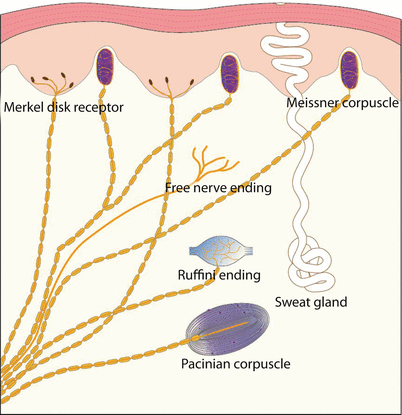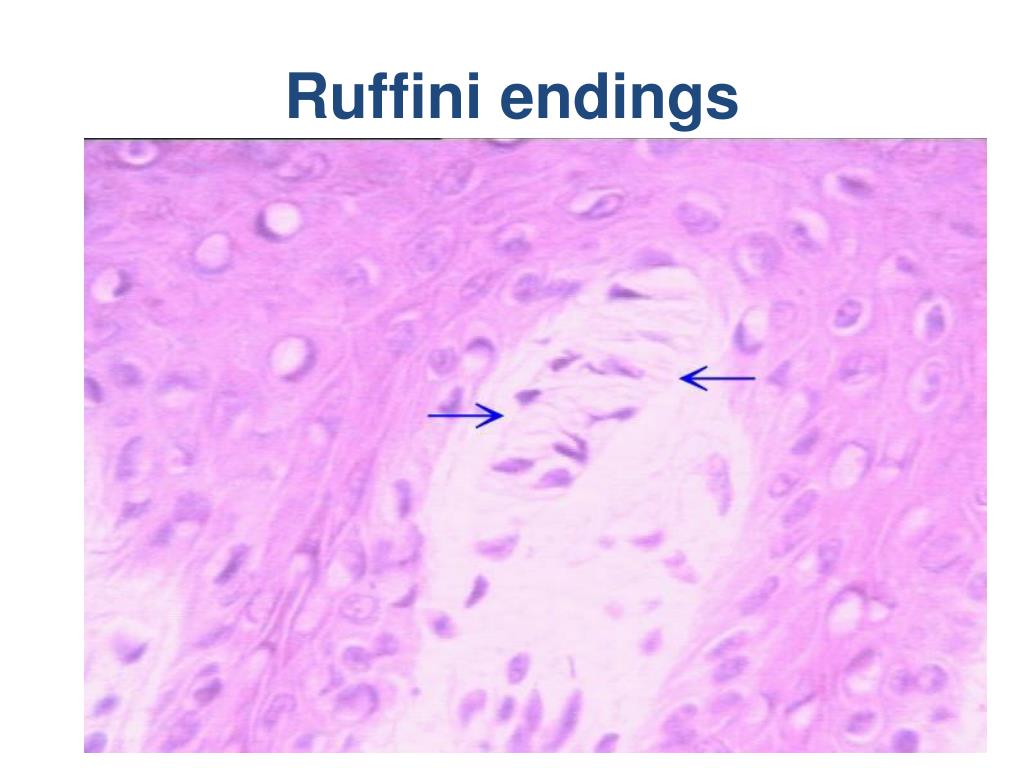
#RUFFINI ENDINGS SKIN#
Art Connection Four of the primary mechanoreceptors in human skin are shown. That makes them finely sensitive to edges and they come into use in tasks such as typing on a keyboard. The receptive fields of Merkel’s disks are small with well-defined borders. Light touch, also known as discriminative touch, is a light pressure that allows the location of a stimulus to be pinpointed. They are slow-adapting, encapsulated nerve endings, and they respond to light touch. Merkel’s disks are densely distributed in the fingertips and lips. Merkel’s disks (shown in Figure) are found in the upper layers of skin near the base of the epidermis, both in skin that has hair and on glabrous skin, that is, the hairless skin found on the palms and fingers, the soles of the feet, and the lips of humans and other primates. A fifth type of mechanoreceptor, Krause end bulbs, are found only in specialized regions. They contain mechanically gated ion channels whose gates open or close in response to pressure, touch, stretching, and sound.” There are four primary tactile mechanoreceptors in human skin: Merkel’s disks, Meissner’s corpuscles, Ruffini endings, and Pacinian corpuscles two are located toward the surface of the skin and two are located deeper. Mechanoreceptors sense stimuli due to physical deformation of their plasma membranes.

There are three classes of mechanoreceptors: tactile, proprioceptors, and baroreceptors. They are slow to adjust to a stimulus and so are less sensitive to abrupt changes in stimulation.
#RUFFINI ENDINGS FREE#
Free nerve endings are sensitive to painful stimuli, to hot and cold, and to light touch. Free nerve endings are the most common nerve endings in skin, and they extend into the middle of the epidermis. A free nerve ending, as its name implies, is an unencapsulated dendrite of a sensory neuron. Mechanoreceptors in the skin are described as encapsulated (that is, surrounded by a capsule) or unencapsulated (a group that includes free nerve endings). What is commonly referred to as “touch” involves more than one kind of stimulus and more than one kind of receptor. These categories are based on the nature of stimuli each receptor class transduces. Sensory receptors are classified into five categories: mechanoreceptors, thermoreceptors, proprioceptors, pain receptors, and chemoreceptors. (credit: modification of work by Don Bliss, National Cancer Institute) Somatosensory Receptors Mammalian skin has three layers: an epidermis, a dermis, and a hypodermis. The hypodermis, which holds about 50 percent of the body’s fat, attaches the dermis to the bone and muscle, and supplies nerves and blood vessels to the dermis. Below the epidermis and dermis is the subcutaneous tissue, or hypodermis, the fatty layer that contains blood vessels, connective tissue, and the axons of sensory neurons. Below this, the much thicker dermis contains blood vessels, sweat glands, hair follicles, lymph vessels, and lipid-secreting sebaceous glands ( Figure). The epidermis serves as a barrier to water and to invasion by pathogens. It is relatively thin, is composed of keratin-filled cells, and has no blood supply. Recall that the epidermis is the outermost layer of skin in mammals. A variety of receptor types-embedded in the skin, mucous membranes, muscles, joints, internal organs, and cardiovascular system-play a role. Somatosensation occurs all over the exterior of the body and at some interior locations as well.

Somatosensation is also known as tactile sense, or more familiarly, as the sense of touch. Stanley Finger, PhD, Professor Emeritus of Psychological & Brain Sciences, Washington University (St.Somatosensation is a mixed sensory category and includes all sensation received from the skin and mucous membranes, as well from as the limbs and joints. Reading like a collection of detective stories, Your Brain, Explained combines classic cases in the history of neurology with findings stemming from the latest techniques used to probe the brain’s secrets. Dean Burnett, PhD, author, Happy Brain and Idiot Brain Moheb Costandi, author, Neuroplasticity and 50 Human Brain Ideas You Really Need to KnowĪn informative, accessible and engaging book for anyone who has even the slightest interest in how the brain works, but doesn’t know where to begin. Frank Amthor, PhD, Professor of Psychology, The University of Alabama at Birmingham, author, Neuroscience for Dummiesĭingman weaves classic studies with modern research into easily digestible sections, to provide an excellent primer on the rapidly advancing field of neuroscience. a highly readable and accessible introduction to the operation of the brain and current issues in neuroscience.


 0 kommentar(er)
0 kommentar(er)
